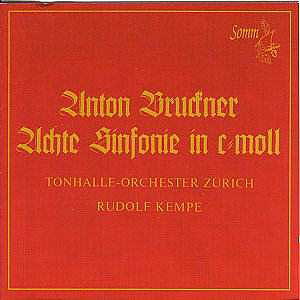Kempe became director of the Zurich Tonhalle Orchestra in 1965
and this recording of Brucknerís Eighth Symphony dates from the final
period that came to an end in 1972. He uses the Haas edition. There is
no doubt about it. This is a lucid, natural performance with considerable
momentum and one apparently unconstrained by the studio red light. Flexibility
coexists with that Kempe feeling for direction to sure effect. Frequently
incisive and with often well-prepared climaxes the contours of the movements
emerge in strong relief. And yet something is missing.
There is subtlety of rubato in the first movement but
the strings donít really sing out to full effect. The preparation for
the trumpets at 8í40 is fine with malleably forward pressure but the
brass themselves, here and elsewhere, are not optimally blended and
lack finesse. The recording tends also to highlight the relative brazenness
of their attack. But at 11í30 the reduced dynamics and affectionate
string moulding is undeniably moving and Kempe shapes this and the succeeding
paragraphs with real insight and imagination. In the Scherzo he is two
minutes quicker than, say, the recent recording by Skrowaczewski (Arte
Nova 74321340162) but he is intelligently alert to the importance of
the trio section and nothing sounds unduly rushed. The Adagio encourages
depth of string tone, burnished and lyrical, without saturation. The
gradients are powerful as are the gradations of the climaxes. I admired
the cushion of string tone after the brass perorations and the sure
balancing of the harp. The orchestral near stasis at 16í02 is followed
by a sure instinct for forward motion though Brucknerians of a more
seasoned nature will probably have preferred a less energetic view of
the adagio. Kempeís way with the finale is best exemplified by the brass
outburst at 6í30. Itís rather too raucous and insistent for my liking
and I felt the finale suffered, cumulatively, from too much insistence
generally. Itís good to have Kempeís Bruckner available but itís not
a central recommendation. Sommís presentation is good and I liked the
Gothic script and elegant design. Itís just that it housed a performance
that was a little too agnostic for me.
Jonathan Woolf


